#UX/UI Design Case Study
Explore tagged Tumblr posts
Text
Digital Innovation at Its Best: The Finch Design's UI UX Overhaul for Hindu Yuva
Explore The Finch Design's radical revamp of the Hindu Yuva website, a non-profit organization for Hindu youth in the United States. Our UI/UX overhaul improved aesthetics, navigability, and brand communication, enhancing user experience and fostering increased engagement. Discover how our design decisions resonated with the tech-savvy youth, conveying Hindu Yuva's core ethos with clarity and visual appeal.
0 notes
Text

Rando Loops: Optimized Experience & Animations Update
#Rando Loops#UI Design#UX Design#Motion UI#Interface Animation#Smooth Interactions#App Update#Design Evolution#Playful UI#Mobile UI#Game Design#Dribbble#Creative Process#UX UI#App Experience#Interaction Design#Digital Product#Visual Design#Microinteractions#Mockup#Case Study Coming Soon
0 notes
Text
#ui/ux#ui/ux design#ux design#ROI of UI/UX#UI UX Case study#Website design#User Experience (UX)#web development#website UI UX
0 notes
Text
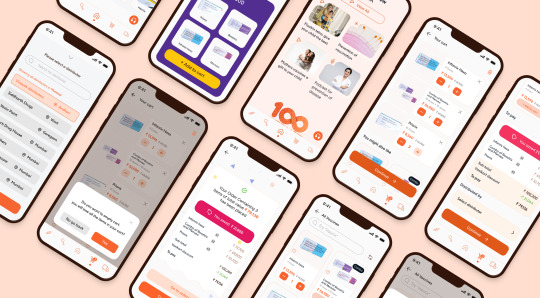
Imagine being an HCP, working in a high-pressure environment where time is of the essence. You’re responsible for ensuring your patients have access to life-saving vaccines, yet the process for ordering them remains stuck in the past. Paper orders, phone calls, and face-to-face interactions were still the norm — methods that, while familiar, were time-consuming and inefficient. GSK had developed an app meant to modernize this process. But when HCPs first began using it, the feedback was overwhelmingly clear: the app was clunky, unintuitive, and difficult to navigate. Out of 11,000 potential users, only 3,000 HCPs gave it a try, and even they quickly reverted to their old habits. The app, intended to simplify the process, was actually creating more barriers. As a result, vaccine sales plummeted by 70%, severely affecting accessibility. My role was to reimagine the experience from the ground up, with the HCP’s needs at the core. I had to understand their daily challenges — fast-paced environments, limited time, and the need for a seamless workflow. By diving deep into user feedback and studying their pain points, I began reshaping the app into a tool that would fit effortlessly into their workday, rather than disrupt it. The goal was simple: make the app as intuitive and accessible as possible, ensuring that HCPs could easily order vaccines with minimal effort. By focusing on usability and streamlining the interface, we aimed to increase engagement, sales, and, most importantly, vaccine accessibility. This project was not just about fixing an app — it was about empowering healthcare professionals to better serve their patients by giving them the tools they needed to do their jobs more efficiently. And in doing so, we were able to turn things around, increasing both sales and usage, and ultimately improving the availability of essential vaccines.
#ui ux design#design#appdesigners#vaccines#pharmaceutical#get vaccinated#mnc#case study#user interface#business#customer experience#profit#omnichannel
1 note
·
View note
Text
Case Study : Redesigning Kingdom Hearts for Mobile Gamers
Context
Video games should be a universal experience, but increasingly, older gamers find themselves isolated from it due to games' lack of accessibility.
Kingdom Hearts is an action role-playing game developed by Square Enix and released on the PlayStation 2 in 2002. The game features an action-oriented battle system, a role-playing leveling system, and a few smaller mini-game sections between worlds. For the redesign, the plot will not be affected by any changes. However, it would be made more for users to play on the go for a quick burst or while sitting and relaxing at home for a longer more, “system-like” play.
Objective
Redesign the UI of a nonmobile game, Kingdom Hearts, into a mobile gaming experience accessible to elders.
Implementation
Menus

| Pause Menu
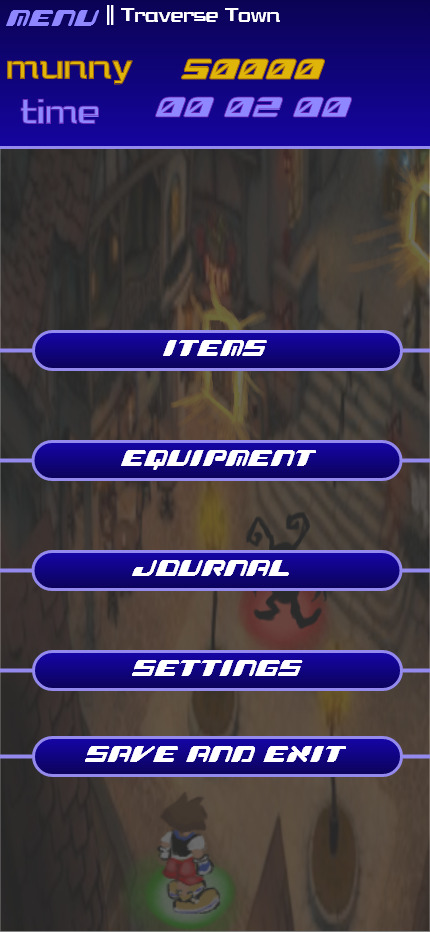
| Redesigned Pause Menu
Menus would be streamlined in the gaming process so that the elder player can spend more playtime in-game rather than in menus. Many of the previous menu options are now automatically added to the player (upgrades and abilities) or are not needed anymore (status and customize).
Exploration
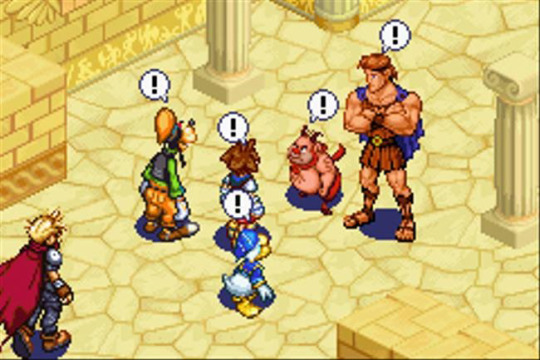
| Kingdom Hearts: Chain of Memories Isometric Camera

| Redesign UI camera and main UI
Originally, Kingdom Hearts used a 3rd Person camera that is known to be very floaty, difficult to control, and overall unresponsive. For the redesign, the camera would be isometric and follow the character as it moves. For an older player, I wouldn’t want them to have to think about the camera in any way or move it. This type of camera was only used one other time in the series for the title Kingdom Hearts: Chain of Memories for the Gameboy.
The player character, Sora, has a glowing green dot under him for visual contrast and so he is more noticeable to elder players especially if other characters or enemies are on screen. Enemies in the game have a red spot under them and they stand in one spot, unmoving, unlike the original game.
Within exploring the game world, there would be a color system for doors. If a door leads to another accessible area it would glow: Red for boss areas and gold for normal areas. This change was because the original game has a lot of painted on doors for textures and I wanted the player to be clear on where they can go.
A mini-map would be added to the game, to assist navigation. Though the first game lacks one, this was later corrected in newer entries. Some areas of Kingdom Hearts are known to be hard to navigate and I believe this quality-of-life change will help a lot with navigation. On the mini map, doors are marked either gold or red just like in the overworld. The player is also marked with a green dot. The mini-map will also be stagnant and not move.
World Map and Gummi Ship Minigame

| World Map

| Gummi Ship Mini Game

| Redesigned world map
For these two sections, there are no major changes because they are already simple and straightforward.
For the world map, I only changed the way the battle level is displayed, I used numbers out of 10 instead of the star system because I believe it’s easier to understand. The only change I would give gummi sections is making them shorter, making the HP and MP bars like the new battle ones (introduced below), and giving the ship automatic upgrades instead of having to build and add them yourself because, in the original game, this system is confusing and unfun.
Battle System, Magic, and Item Change

| Standard battles in Kingdom Hearts
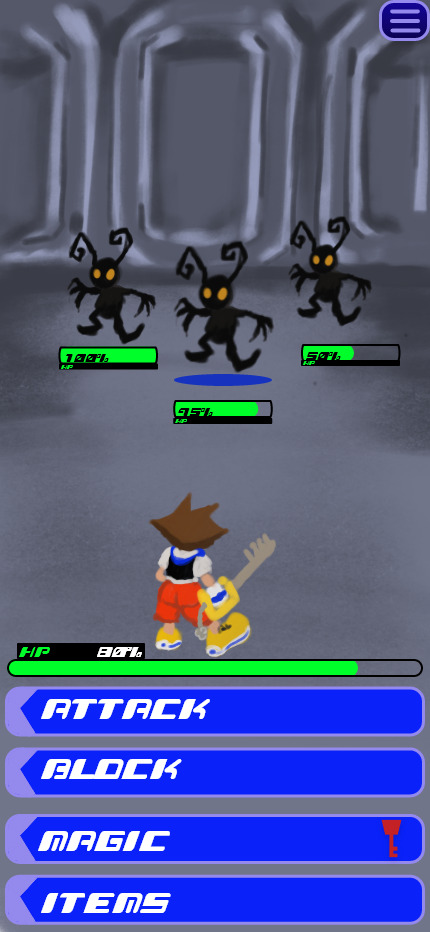
| Redesigned Battles (showing Health Points)
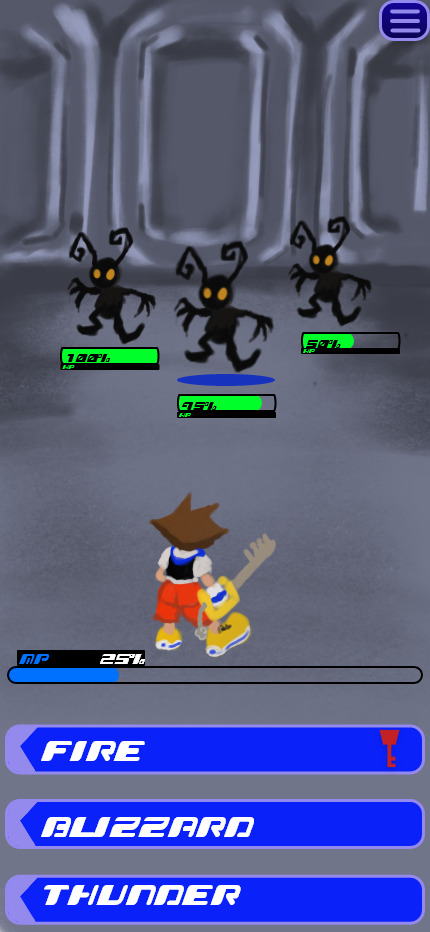
| Redesigned Battle (showing Magic Points)
To make Kingdom Hearts more accessible and easier on a mobile format, I decided to change from an action battle system to a turn-based battle system. Action games require quick reflexes and timing, two things that decrease as a person ages, however; for a turn-based game, the player will not have to worry about reaction times or reflexes, they may take as long as they like to go through battles. The camera during this section would not change, only the characters would move.
Health Points (HP) and Magic Points (MP) would be displayed differently. Instead of the radial style used in the original, I opted for using bars for a simpler look. HP will display directly under the player character in most menus, only when clicking the "Magic" menu will the bar change to show the player's MP. This change is to help with managing the different point systems so the battle UI is not cluttered. Number percentages would be added to both bars to help with understanding the number of points left. For enemies, the HP bar will always be shown under the enemy and will not need to be unlocked like in the original game. Under the enemy that’s being targeted, a blue circle will be shown. For each battle, HP and MP will replenish back to 100% for the player.
To adapt to a mobile format, made changes to the command menu that Kingdom Hearts uses for battles. Instead of having to scroll through and select, the player can simply tap the button for attacking, blocking, magic and items. Within this I also made a change to items used in battles, only three would be available to players: Potion (for healing HP), Ether (for healing MP), and Antidote for status effects. All status effects would be able to heal with Antidote instead of having different items for statues, this makes item management much simpler for an elderly player.
The magic system now lists all the magic available and automatically upgrades to the stronger version of the spell instead of having to equip it, taking away the need to prep outside of battles and streamlines the playing experience.
The party system would work similarly to other games with the party member characters attacking/healing/blocking on their own however I would like the party members to be programed to heal the player character’s health or magic more often than themselves so that it’s less that an elderly player would have to worry about, and they can focus on attacking the enemies.
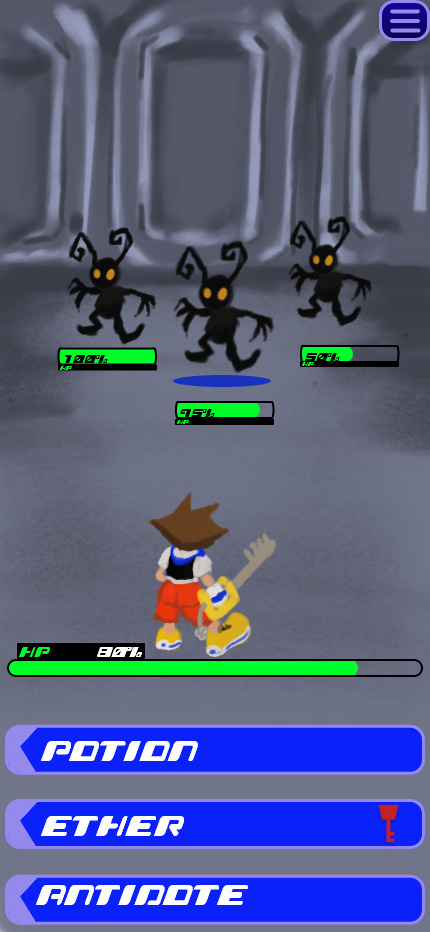
| Redesigned Item Menu
#ux#ui#ur#portfolio#ui ux design#kingdom hearts#case study#kingdom hearts redesign#user experience#user interface#user research
1 note
·
View note
Text
The ROI of Great Web Design: How a Smart Website Boosts Your Business
There's a secret weapon for boosting your online success... and it's not what you think! Discover the power of exceptional web design in our new eBook.
In today’s digital age, your website is your storefront to the world. But is it a thriving marketplace or a dusty forgotten corner? This ebook, written by Mwenya Chongo, CEO of Mukwood Digital Web Design Studio (registered in Zambia), dives deep into the power of well-crafted web design and how it directly impacts your business’s bottom line. Uncover the hidden potential of your website and…
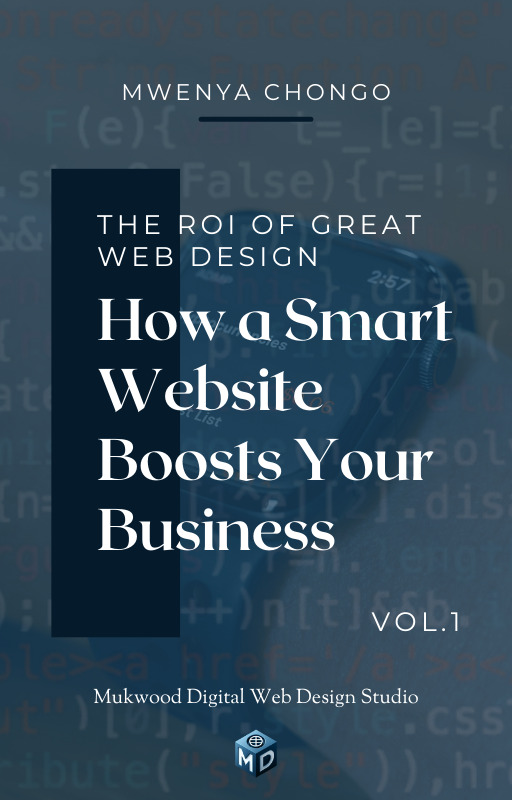
View On WordPress
#affordable web design#best web design companies#branding#Content Marketing#conversion rate optimization (CRO)#digital marketing#domain name registration#ecommerce website design#email marketing#graphic design#information architecture#landing page design#logo design#mobile-friendly web design#responsive web design#responsive web design cost#ROI for web design#search engine marketing (SEM)#SEO cost#SEO web design#social media marketing#user experience (UX) design#user interface (UI) design#web analytics#web copywriting#web design#web design agency#web design case studies#web design for non-profits#web design for small businesses
0 notes
Text
Designing the Future: A Designer’s Insight into the Role of UI Case Studies
As designers, we're not just creating websites but crafting experiences. In this journey, UI case studies aren't just helpful; they're essential. They are our guides, our inspiration, and our lessons learned, helping us bridge the gap between aesthetic appeal and functional brilliance.

The Evolution of Web Design and UI
Remember the days of simplistic, text-only websites? We've come a long way since then. Today, UI isn't just a part of web design; it's the heart of it. It's where art meets user needs, where every pixel can make a difference in the user experience.

Understanding UI Case Studies
For us designers, UI case studies are like stories with a moral. They detail the journey of a UI project, from the first sketch to the final user interaction. These narratives are a goldmine of information, showing us the 'why' behind every design decision.
Why UI Case Studies are Crucial Today
Learning from Successes and Failures: They’re like a seasoned mentor, showing us what works and warning us about what doesn’t.
User-Centric Design: These studies remind us to keep our designs focused on the user, making sure our creations are as intuitive as they are beautiful.
Innovative Solutions: They’re our muse, offering creative solutions to the unique challenges we face in our design endeavors.
Benchmarking and Standards: They help us gauge our work against the best in the industry, pushing us to aim higher.

Impact on Business and Branding
A well-executed UI is a silent ambassador for the brand. It’s more than just a pretty face; it’s a tool that can elevate user engagement and conversion, directly impacting the business’s bottom line.
Integrating UI Case Studies into the Design Process
Incorporating lessons from these case studies is like adding secret ingredients to our design recipe. It involves iterative improvements guided by real-world feedback and data, ensuring our designs are always evolving and improving.
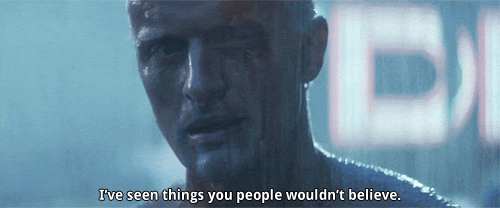
Future of UI Design and Case Studies
Looking ahead, UI design is set to become more personalized and more intuitive. As AI and immersive technologies weave into our design canvas, the role of case studies will also evolve, offering new insights into these uncharted territories.
For us designers, UI case studies are more than just a reference point; they are a source of inspiration and learning. As we navigate the intricacies of crafting digital experiences, these studies provide invaluable insights, helping us create designs that look great and resonate deeply with users.
I explored some of the case study references from one of the leading UI/UX agencies in the USA- Pepper Square, and I've mentioned it above.
Please add more in the comments if you find more.
1 note
·
View note
Text
0 notes
Text
Ok this is a bit of a wordy post but bear with me. I've been reading up on the tech literacy discourse and I thought I'd add my two cents, and how it connects to piracy. LONG post under the cut!
I was born in the year 2000, which puts me on the border of being a digital native. I was brought up on tech, but only in my later childhood and teens. I've always considered myself "tech literate," but no more than the usual kid my age.
The first time I ever truly experienced tech illiteracy with my peers was when I was 23, when in one of my college classes a MacOS update rendered the software we used for said class unusable. After a few days a temporary patch was released, which by that point an assignment that utilized the software was due the next day. I followed the patch instructions, which involved navigating to the software files and substituting a designated file with the provided patch. A bit more complicated than a simple update, but the instructions were clear and intuitive enough to easily understand where the file went. The next day, during a class study session, I overheard multiple people come up to the professor complaining that the software wasn't working. After the second person complained with the professor being clueless, I asked the student what MacOS version they were on. Sure enough they were on the latest version, which as we already know is incompatible with the software. I then walked the student through the patching process step-by-step, with them needing to essentially be hand held through the entire process (almost to the point of me doing everything for them). After the patch was implemented, the student thanked me and said "Wow! How did you figure all of this out?" and to me that question was stupid- I just googled "[software] [version] MacOS [version] fix", went to the first result (which was the company website), downloaded the patch zip file, and followed the instructions on the README.txt file. It was so easy, and I couldn't comprehend that this was somehow complicated for other people, especially those my age. I mean we literally grew up using computers. It wasn't until I started learning about tech literacy and learned helplessness that I finally started connecting the dots.
Tech in general is becoming extremely user friendly, almost to a fault. UI and UX simplicity is taking away any critical thinking needed to use any sort of tech. My peers are so used to one-click and/or automatic updates, so the fact that this required slightly more effort than a simple update triggered their learned helplessness. The professor was no help in this case either, since he just extended the due date for those affected with no penalty. I actually ended up making a very detailed (and I mean idiot proof detailed) step by step picture guide with screenshots on how to install the patch for the software for the class. Anyways, back to the main point- How can I blame my peers for not knowing how to install a "complicated" update when they're so used to being spoon-fed simplicity?
But hang on- how was I the exception? I'm just as used to tech simplicity as anyone else, it's not like I'm using anything differently or making things harder for myself on purpose (I'm looking at you, linux users). So why was I the only one who knew how to install this update? It wasn't until I had a discussion many months later with my mom about this tech illiteracy epidemic that I finally thought it through. I acquired problem solving skills through piracy. To start off: not piracy but adjacent- learning to install mods in Minecraft when I was 11 taught me file navigation and what a README.txt file was, as well as the importance of version specificity/compatibility. Figuring out how to play Pokemon roms on the family computer and my iPod touch when I was 12? That's piracy, and it also taught me how to work with different platforms and the art of jailbreaking. Installing custom firmware on my 3ds so I could pirate games when I was 16 taught me how to follow written tech instructions without any visual guidance. Pirating Adobe software on my MacBook in high school taught me about patching files on MacOS. All of this knowledge and inherent googling that came with it made installing the patch for my class software look like a tiny drop in the bucket in terms of complexity.
So why am I saying all of this? Am I suggesting people learn to pirate to become tech literate?
yes.
With everything becoming pay-walled, subscription services running rampant, the proliferation of closed-source "ecosystems" *cough* Apple *cough*, and (arguably) most importantly media preservation, piracy is a skill that will serve you well in the long term. It will teach you critical thinking in the tech sphere, and if enough people learn then we can solve this ever growing epidemic of tech illiteracy. I'm not really sure how to end this post, so if anyone has anything else they'd like to add please feel free to.
Thank you for coming to my ted talk.
43 notes
·
View notes
Text
My portfolio was selected as portfolio of the day on this site. That's the second this year. I feel honored. Thank you.
7 notes
·
View notes
Text
about me / sobre mim
[about me] [br/eng]
˚✧ antiseptic ݁ ੭
ela/dela I she/her🥀 19y 🖤 goth!~
eu sou a danielle, mas podem me chamar de moon, lilith, antiseptic, como preferirem! tenho 18 anos e estudo design ux/ui e figma, pretendo cursar uma faculdade de design grafico e quero ingressar na area mais cedo possivel. criei um blog pra postar meus processos criativos e conseguir alguns freelancers~
meu maior objetivo com esse blog é divulgar meus processos criativos com websites, quero me desenvolver com críticas e sugestões e colocar meus conhecimentos em prática, adquirindo todos os estilos e extensões de mundo e conhecer essa área incrível ♥︎ almejo conseguir alguns freelancers e pequenos trabalhos relacionados a:
website;
layouts;
cardápios digitais;
cartões de visita;
interfaces gerais;
interações com o usuário.
tudo o que possa haver com design, resumindo...
mas não quero usar esse blog como uma área profissional, quero compartilhar meus designs mas interagir de forma pessoal e não usarei de forma alguma como empresarial! (apenas quero alguns trabalhos, hihi)
✩ ︵ sou uma designer iniciante e sempre fui apaixonada pela teoria e estética desse mundo, ingressei ano passado na área e tenho feito grandes progressos com meus estudos. atualmente estudo ingles e alemao, amo gatos (sou mãe de quatro doidos) sou amante de café e jogo lol e genshin impact, caso queiram interagir sobre isso <3 (arlecchino e raiden shogun supremacy) ﹕
minhas ask's estão sempre abertas, então se sintam a vontade para me fazer perguntas ou conversar comigo ♥︎
alguns links que possam ser uteis:
te enganei :D nao tem nada! (em breve)⠀ 𓈒⠀ ⠀✧
IN ENGLISH, PLEASE!?
i'm danielle, but you can call me moon, lilith, antiseptic, whatever you prefer! I'm 18y and study UX/UI design and figma, planning to attend a graphic design college and aiming to enter the field as soon as possible. I've created a blog to share my creative processes and to find some freelancers~
my biggest goal with this blog is to showcase my creative processes with websites. i want to develop myself with critiques and suggestions and put my knowledge into practice, acquiring all styles and extensions of the world and getting to know this amazing field ♥︎ I aim to get some freelancers and small jobs related to:
websites;
layouts;
digital menus;
business cards;
general interfaces;
user interactions.
anything and everything related to design, in short...
i don't intend to use this blog as a professional platform; rather, I want to share my designs while interacting on a personal level. i won't use it in any way for business purposes! (just looking for some fun projects, hihi)
✩ ︵ i'm a beginner designer and have always been passionate about the theory and aesthetics of this world. i entered the field last year and have made great progress with my studies. currently, i'm studying english and german, i love cats (i'm a mother of four crazy ones), i'm a coffee lover, and I play lol and genshin impact, in case you want to interact about that <3 (arlecchino and raiden shogun supremacy) ﹕
my asks are always open, so feel free to ask me questions or chat with me ♥︎
some useful links:
i got you :D there's nothing here! (coming soon)⠀ 𓈒⠀ ⠀✧
#freelancedesign#apresentação#apresentation#introduction#designgraphic#designergrafico#cat lovers#coffeeaddict#gaming#gamingcommunity#genshin impact#league of legends#brasil#english#aesthetic#art#gothic#goth aesthetic#gotico#arlecchino genshin#arlecchino#raiden shogun#raiden ei#yae miko#genshin#genshinimpact#design#graphic design#designinspiration#digital art
11 notes
·
View notes
Text
UX Design Strategies for Improving Conversion Rates
In the competitive landscape of digital products and services, achieving high conversion rates is crucial for success. Whether it's driving sales, capturing leads, or encouraging user engagement, optimizing the user experience (UX) is essential for improving conversion rates. In this article, we'll explore effective UX design strategies that can help boost conversion rates and drive business growth.
1. Understand Your Users:
One of the foundational principles of UX design is understanding your target audience. Conduct user research to gain insights into your users' needs, preferences, and behaviors. Identify key user personas and create user journeys to map out the steps users take to complete desired actions. By understanding your users' motivations and pain points, you can design experiences that resonate with them and encourage conversion.
2. Simplify the User Journey:
Streamline the user journey to reduce friction and make it easy for users to complete desired actions. Remove unnecessary steps, simplify forms and checkout processes, and guide users through clear and intuitive pathways. Minimize distractions and design with clarity and simplicity in mind to keep users focused on the task at hand. By simplifying the user journey, you can reduce barriers to conversion and increase completion rates.
3. Optimize Page Speed and Performance:
Page speed and performance have a significant impact on user experience and conversion rates. Slow-loading pages can frustrate users and lead to high bounce rates and abandoned sessions. Optimize your website or app for speed by optimizing images, minifying code, leveraging browser caching, and using content delivery networks (CDNs). Monitor performance metrics regularly and make improvements to ensure fast and seamless experiences for users.
4. Implement Clear Calls-to-Action (CTAs):
Effective calls-to-action (CTAs) are essential for guiding users towards conversion. Use clear and compelling language to communicate the value proposition of your CTAs and encourage users to take action. Place CTAs prominently on relevant pages and design them to stand out visually. Use contrasting colors, whitespace, and directional cues to draw attention to CTAs and make them easy to find and click. Test different variations to identify which CTAs resonate best with your audience.
5. Leverage Social Proof and Trust Signals:
Social proof and trust signals can help alleviate user concerns and build credibility, ultimately leading to higher conversion rates. Incorporate testimonials, reviews, ratings, and trust badges strategically throughout your website or app to reassure users and validate their decision to convert. Highlight customer success stories, case studies, and endorsements to demonstrate the value of your products or services and inspire confidence in potential customers.
6. Continuously Test and Iterate:
Optimization is an ongoing process in UX design. Continuously test different design elements, layouts, and messaging to identify what resonates best with your audience and drives conversions. Conduct A/B tests, multivariate tests, and user testing to gather data and insights into user behavior and preferences. Use this data to inform iterative design improvements and optimizations that lead to incremental gains in conversion rates over time.
Conclusion:
Improving conversion rates requires a holistic approach to UX design that focuses on understanding user needs, simplifying the user journey, optimizing performance, and leveraging persuasive design elements. Enrolling in a UI course can equip designers with the skills and knowledge needed to implement effective user interface design strategies that complement UX efforts and further enhance conversion rates.
2 notes
·
View notes
Text
UI/UX Design Agency in the USA : Enhancing Digital Experiences
In today's digital age, user experience (UX) and user interface (UI) design play a critical role in the success of online businesses. As more companies realize the importance of providing intuitive and engaging digital experiences to their users, the demand for skilled UI/UX design agencies is on the rise. In the USA, particularly in California, a hub of technological innovation, UI/UX design agencies are helping businesses elevate their online presence and drive growth.
Importance of UI/UX Design for Businesses
UI/UX design is not just about making a website or app visually appealing; it's about creating an experience that delights and engages users. A well-designed user interface ensures that users can easily navigate a website or app and find the information they need. On the other hand, a good user experience design focuses on the emotional aspect of the interaction, ensuring that users have a positive impression of the brand.
What is a UI/UX Design Agency?
A UI/UX design agency is a company that specializes in creating user-friendly interfaces and experiences for websites, mobile apps, and other digital products. These agencies employ a team of designers, developers, and user experience experts who work together to create compelling digital experiences that meet the needs of both businesses and their users.
UI/UX Design Agency Services
UI/UX design agencies offer a range of services to help businesses improve their digital presence. These services may include user research, wireframing, prototyping, and usability testing. By employing a holistic approach to design, these agencies can create seamless and intuitive experiences that drive user engagement and satisfaction.
How to Choose the Right UI/UX Design Agency
Choosing the right UI/UX design agency is crucial for the success of your project. When selecting an agency, consider factors such as their portfolio, expertise, and client reviews. It's also important to ensure that the agency understands your business goals and can tailor their services to meet your specific needs.
Top UI/UX Design Agencies in the USA
The USA is home to many top-tier UI/UX design agencies that have earned a reputation for excellence in the field. Some of the leading agencies include IDEO, Frog Design, and us two. These agencies have worked with some of the biggest brands in the world and have a proven track record of delivering exceptional design solutions.
UI/UX Design Agency in California
California, with its vibrant tech scene, is a hotbed for UI/UX design agencies. Companies in California benefit from the state's innovative spirit and access to top talent. Some of the notable UI/UX design agencies in California include RNO1, Ramotion, and Clay. These agencies are known for their creative approach to design and their ability to deliver results that exceed client expectations.
Case Studies of Successful UI/UX Design Projects
To illustrate the impact of UI/UX design, we can look at some real-world examples of successful projects. For instance, Airbnb's redesign of its website and app led to a significant increase in user engagement and bookings. Similarly, the redesign of the Starbucks app resulted in a 40% increase in mobile orders. These case studies highlight the importance of investing in good design for business success.
Trends in UI/UX Design
UI/UX design is a constantly evolving field, with new trends and technologies emerging all the time. Some of the current trends in UI/UX design include dark mode, 3D elements, and micro-interactions. By staying abreast of these trends, UI/UX design agencies can create designs that feel fresh and modern.
Future of UI/UX Design
Looking ahead, the future of UI/UX design looks promising. As technology continues to advance, we can expect to see more immersive and interactive digital experiences. AI and machine learning are also likely to play a bigger role in UI/UX design, helping to personalize the user experience and streamline design processes.
Conclusion
In conclusion, UI/UX design is a critical aspect of modern business success. By investing in good design and working with a reputable UI/UX design agency, businesses can create digital experiences that delight users and drive growth. Whether you're in the USA or California, there are plenty of top-tier agencies ready to help you elevate your digital presence.
FAQs
What is the difference between UI and UX design? User interface (UI) design focuses on the visual elements of a digital product, such as layout, colors, and typography. User experience (UX) design, on the other hand, is concerned with the overall feel of the product and how users interact with it. How can UI/UX design benefit my business? UI/UX design can benefit your business by improving user satisfaction, increasing user engagement, and driving conversions. A well-designed digital product can also help enhance your brand image and credibility. How much does it cost to hire a UI/UX design agency? The cost of hiring a UI/UX design agency can vary depending on the scope of your project and the agency's expertise. It's best to get quotes from several agencies and compare their services and pricing before making a decision. What should I look for in a UI/UX design agency? When choosing a UI/UX design agency, look for a company with a strong portfolio, relevant experience, and positive client reviews. It's also important to ensure that the agency understands your business goals and can deliver results that align with your vision. How can I stay updated on the latest UI/UX design trends? To stay updated on the latest UI/UX design trends, consider following industry blogs, attending design conferences, and networking with other professionals in the field. Additionally, subscribing to design newsletters and joining online communities can help you stay informed.
3 notes
·
View notes
Text
Digital marketing online course in Mohali and Chandigarh | Param digital marketing
Digital Marketing Course – Learn Online and Save Money
Below is an outline of an online digital marketing course content. This content is a general guideline and can be adapted and expanded based on the specific needs of the course and the level of expertise of the learners. Learn Advanced Digital Marketing with DKI and DSA Ads only in 29999/– now – Join Now
Digital marketing online course in Mohali and Chandigarh.

Understanding digital marketing and its importance
Evolution of digital marketing
Digital marketing vs. traditional marketing
Key concepts and terminology
Book Class Now
Module 2: Website Planning and Development
Importance of a website in digital marketing
Domain registration and hosting
Website design principles and best practices
User experience (UX) and user interface (UI)
Mobile responsiveness and optimization
Introduction to Content Management Systems (CMS) like WordPress
Module 3: Search Engine Optimization (SEO)
Want to join click here
Understanding search engines and how they work
On-page SEO: Keyword research, Density and Proximity, meta tags and Description, headings, content and image optimization
Off-page SEO: Link building, backlinks, and domain authority, DA/PA Checking
Technical SEO: Website speed, site structure, and crawlability, Mobile Friendly, Security
Local SEO and Google My Business Page Optimization
Module 4: Content Marketing
Importance of quality content writing in the digital landscape
Creating a content writing strategy
Types of content: blog posts, articles, infographics, videos, etc.
Content promotion and distribution
Content analytics and measuring success
Module 5: Social Media Marketing
Overview of major social media platforms (Facebook, Twitter, LinkedIn, Instagram, Pinterest, Tumblr etc.)
Creating a social media strategy
Social media advertising and sponsored posts, Event Creating
Building and engaging with an online community
Social media analytics and performance tracking
Module 6: Email Marketing
Building an email marketing list
Creating effective email campaigns
Email marketing tools and platforms
Personalization and segmentation
Analyzing email marketing performance
Module 7: Pay-Per-Click (PPC) Advertising
Introduction to PPC Advertising and Google Ads
Creating PPC campaigns and ad groups
Keyword research and selection
Ad copywriting and A/B testing
Bid strategies and budget management
Module 8: Display and Banner Advertising
Understanding display advertising and its formats
Display advertising platforms (Google Display Network, etc.)
Targeting options for display ads
Designing effective banner ads
Display ad performance tracking and optimization
Module 9: Video Marketing
The rise of video content in digital marketing
Creating engaging video content
Video SEO and optimizing for platforms like YouTube
Video advertising and sponsored content
Analyzing video marketing metrics
Module 10: Analytics and Data-driven Marketing
Introduction to marketing analytics
Setting up Google Analytics and understanding key metrics
Data analysis for decision-making
A/B testing and conversion rate optimization (CRO)
Customer journey and attribution modeling
Module 11: Mobile Marketing
Mobile marketing trends and opportunities
Mobile app marketing and optimization
SMS marketing and push notifications
Mobile advertising and location-based marketing
Mobile analytics and tracking
Module 12: Digital Marketing Strategy and Planning
Developing a comprehensive digital marketing strategy
Integrating various digital marketing channels
Budget allocation and resource planning
Measuring ROI and KPIs for digital campaigns
Case studies and real-world examples
Module 13: Legal and Ethical Considerations
Privacy and data protection laws (e.g., GDPR)
Ethical practices in digital marketing
Dealing with online reviews and reputation management
Handling customer data responsibly
Module 14: Emerging Trends in Digital Marketing
Artificial Intelligence (AI) and machine learning in marketing
Voice search and voice-activated devices
Augmented Reality (AR) and Virtual Reality (VR) marketing
Influencer marketing and social media trends
Future outlook and staying ahead in the digital marketing landscape
Module 15: Final Project and Certification
Capstone project applying concepts learned throughout the course
Presentations and feedback sessions
Issuance of course completion certificates
Remember that this is just a general outline, and the content and depth of each module can be adjusted to suit the course’s duration, audience level, and objectives. Additionally, including practical exercises, case studies, and hands-on projects will enhance the learning experience. We provide 100% Job Placement after completion of Course.
Digital marketing online course in Mohali and Chandigarh.
#digital marketing#online marketing#seo services#search engine optimization#mohali#chandigarh#tricity#learning#education#student#university#jobseekers#college#online courses
3 notes
·
View notes
Text
Future of Design in India

A design course is an educational program that focuses on teaching creative and technical skills necessary for various design disciplines. These courses aim to nurture students' artistic abilities, problem-solving skills, and understanding of aesthetics to prepare them for careers in diverse design fields. Design courses cover a wide range of specialties, including graphic design, fashion design, product design, interior design, industrial design, UX/UI design, and more.
These programs typically incorporate both theoretical and practical learning experiences. Students learn about design principles, colour theory, typography, design software, and tools specific to their chosen field. They engage in hands-on projects, case studies, internships, and workshops to gain real-world exposure and practical skills.
Design courses are structured to develop a strong foundation in creativity, critical thinking, and technical proficiency. They encourage students to explore their creativity, conceptualize ideas, and translate them into tangible designs. Additionally, these courses often emphasize understanding user needs, market trends, and the role of design in addressing societal and industry challenges.
Future of design?
In India, the future of design courses is poised for significant growth and innovation. The design education landscape is evolving to meet the demands of a rapidly transforming economy and future of design in India is growing. Here's some of the best design courses in India:
Industry Alignment: Design courses will become more closely aligned with industry needs. There will be a greater emphasis on practical skills, industry collaborations, and internships to bridge the gap between academic learning and real-world applications.
Technology Integration: India's design courses will embrace technological advancements, integrating them into the curriculum. This includes adopting AI-driven design tools, AR/VR applications, and data-driven design strategies to stay at the forefront of technological innovation.
Diversification of Specializations: As India's economy diversifies, design courses will offer specialized programs catering to emerging sectors like sustainable design, healthcare design, UX/UI for tech products, and service design for evolving industries.
Entrepreneurial Focus: There will be a heightened focus on nurturing entrepreneurship within design courses. Programs will encourage students to develop entrepreneurial skills, fostering a culture of innovation and enabling graduates to start their design ventures.
Global Perspectives: Design courses in India will increasingly incorporate global perspectives, encouraging international collaborations, exchange programs, and exposure to diverse cultural influences. This will prepare students for a globalized design market and foster cross-cultural understanding.
Socially Responsible Design: With an increased awareness of social and environmental issues, design education will emphasize socially responsible design practices. Students will learn to create solutions that address societal challenges, focusing on inclusivity, sustainability, and ethical design.
Government Support and Initiatives: Initiatives by the government and private sector partnerships will further enhance design education in India. Investments in infrastructure, research, and skill development will contribute to the growth and quality of design courses across the country.
A Bachelor of Design (B.Des) offers a diverse range of career opportunities and scopes for graduates in India. Here's a look at the promising design careers of the future:
Graphic Design: B.Des graduates can pursue careers as graphic designers, creating visual concepts using computer software or by hand to communicate ideas that inspire, inform, or captivate consumers.
Fashion Design: With a B.Des in fashion design, graduates can venture into the fashion industry, working as fashion designers, stylists, merchandisers, or textile designers, creating clothing, accessories, or textiles.
Product Design: B.Des graduates can work as product designers, developing innovative and functional products ranging from electronics to household items, focusing on user experience and aesthetics.
UX/UI Design: In the digital realm, B.Des graduates can become UX/UI designers, creating user-centric interfaces and experiences for websites, mobile apps, and software, enhancing user satisfaction and usability.
Interior Design: Graduates specializing in interior design can pursue careers as interior designers, planning and designing spaces that enhance functionality, safety, and aesthetics.
Animation and Multimedia: B.Des graduates can explore careers in animation, multimedia, and visual effects, working in the entertainment industry, advertising, or gaming sectors.
Automobile Design: Aspiring automobile designers can leverage their B.Des degree to enter the automotive industry, contributing to the design and development of vehicles, focusing on aesthetics and functionality.
Entrepreneurship: B.Des graduates often have the option to start their design ventures, launching their brands, studios, or design consultancy firms catering to various design needs in the market.
The scope for B.Des graduates in India is diverse and expanding. B.Des admissions 2024 are increasing and design course admissions will only be going up in the near future. With creativity, technical skills, and a strong understanding of design principles, graduates can contribute to various industries and sectors. Additionally, the growing emphasis on design thinking and user-centric approaches across industries further amplifies the demand for skilled design professionals.
Shoolini University stands out as the top-tier destination for aspiring UI/UX Designers. Ranked No.1 private university in India by THE World University Rankings 2023, the Yogananda School of AI, Computers, and Data Science at Shoolini offers two specialized courses for UI/UX enthusiasts: BTech CSE UI/UX and BCA UI/UX.
The advantages of pursuing a UI/UX course at Shoolini University are abundant. Here are some highlights:
- Esteemed faculty from renowned institutions like Berkeley, UPenn, Columbia University, Stanford, Oxford, IISc, and IITs.
- Valuable industry collaborations with AWS, IBM, Google Digital Academy, and Bosch offering certifications to students.
- A patent filing encouragement policy, 'One Student One Patent', fostering innovation.
- Extensive international collaborations with 250 universities for student and faculty exchange programs.
- 'Mission 130' dedicated to achieving 100% placements for Engineering students and 30% in top-tier firms.
- Strong recruitment ties with leading companies like Ericsson, HCL, Trident, Citrix, Genpact, Cognizant, and IBM.
- QS I-Gauge 'Diamond Rating' for academic excellence.
- Industry-recognized certifications and robust associations with IBM, Microsoft, and AWS Academy.
- Hands-on learning opportunities with mentors on real-life projects within small teams.
- Access to Siqandar, a top-notch AI interview prep coach, for interview preparation. In conclusion, for those aspiring to excel in the UI/UX design domain, Shoolini University emerges as the premier choice in India. Here at the school of design, your aspirations to embark on a UI/UX design career find a nurturing platform. If technology inspires you, problem-solving thrills you, and crafting exceptional digital experiences is your passion, Shoolini University offers the perfect launchpad of B.Des. degree program. Dedication, continuous learning, and a sprinkle of creativity pave the way to crafting products that captivate users—a fulfilling journey in the realm of UI/UX design awaits! Happy designing!
2 notes
·
View notes
Text
Effective product design is key to business success. This case study highlights how thoughtful design decisions shaped a new product from concept to launch.
Through extensive research and concept testing, identified core user needs - simplicity, versatility and intuitive use. These insights drove the product vision.
An iterative design process focused on maximizing ease of use and multi-functionality. User feedback at each stage guided improvements. The result was a streamlined product with a sleek, user-friendly interface.
This case study shows how human-centered design directly informed the product. By prioritizing user needs and usability, the designers created a product that delights customers.
5 notes
·
View notes